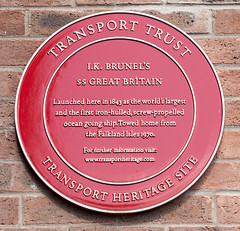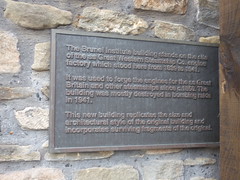SS Great Britain
Commemorated on 3 plaques
Transport Heritage Site 'Red Wheel' #36
SS Great Britain An outstanding example of I. K. Brunel's innovative design that made a significant contribution to society and mechanical engineering. It was the first iron-hulled, screw-propelled vessel to cross any ocean. It was conceived as a key element in the integrated transport system from London to the New World.
Great western Dock, Gasferry Road, Bristol, United Kingdom where it sited (1970)
I. K. Brunel's SS Great Britain Launched here in 1843 as the world's largest and the first iron-hulled, screw-propelled ocean going ship. Towed home from the Falkland Isles 1970.
Gas Ferry Road, Bristol, United Kingdom where it was
The Brunel Institute Building stands on the site of the ss Great Western Steamship Co. engine factory which stood here from 1839 to 1941. It was used to forge the engines for the ss Great Britain and other steamships since c. 1850. The building was mostly destroyed in bombing raids in 1941. This new building replicates the size and architectural style of the original building and incorporates surviving fragments of the original.
Brunel Institute building - Brunel's SS Great Britain, Bristol, United Kingdom where it engines forged (1842)




